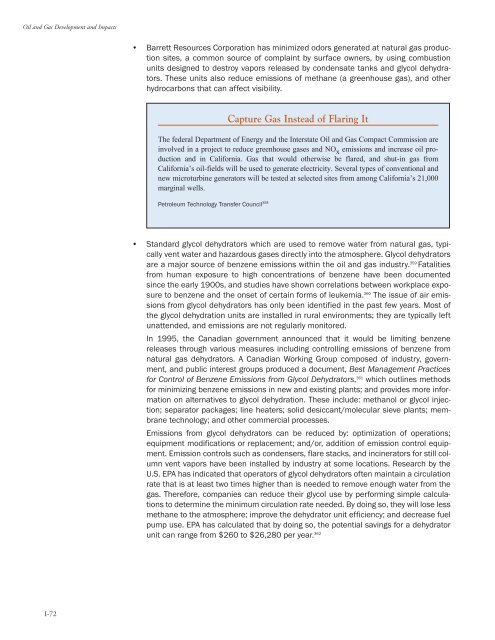Oil and Gas at Your Door? (2005 Edition) - Earthworks
Oil and Gas at Your Door? (2005 Edition) - Earthworks
Oil and Gas at Your Door? (2005 Edition) - Earthworks
You also want an ePaper? Increase the reach of your titles
YUMPU automatically turns print PDFs into web optimized ePapers that Google loves.
<strong>Oil</strong> <strong>and</strong> <strong>Gas</strong> Development <strong>and</strong> Impacts<br />
• Barrett Resources Corpor<strong>at</strong>ion has minimized odors gener<strong>at</strong>ed <strong>at</strong> n<strong>at</strong>ural gas production<br />
sites, a common source of complaint by surface owners, by using combustion<br />
units designed to destroy vapors released by condens<strong>at</strong>e tanks <strong>and</strong> glycol dehydr<strong>at</strong>ors.<br />
These units also reduce emissions of methane (a greenhouse gas), <strong>and</strong> other<br />
hydrocarbons th<strong>at</strong> can affect visibility.<br />
Capture <strong>Gas</strong> Instead of Flaring It<br />
The federal Department of Energy <strong>and</strong> the Interst<strong>at</strong>e <strong>Oil</strong> <strong>and</strong> <strong>Gas</strong> Compact Commission are<br />
involved in a project to reduce greenhouse gases <strong>and</strong> NO x emissions <strong>and</strong> increase oil production<br />
<strong>and</strong> in California. <strong>Gas</strong> th<strong>at</strong> would otherwise be flared, <strong>and</strong> shut-in gas from<br />
California’s oil-fields will be used to gener<strong>at</strong>e electricity. Several types of conventional <strong>and</strong><br />
new microturbine gener<strong>at</strong>ors will be tested <strong>at</strong> selected sites from among California’s 21,000<br />
marginal wells.<br />
Petroleum Technology Transfer Council 358<br />
• St<strong>and</strong>ard glycol dehydr<strong>at</strong>ors which are used to remove w<strong>at</strong>er from n<strong>at</strong>ural gas, typically<br />
vent w<strong>at</strong>er <strong>and</strong> hazardous gases directly into the <strong>at</strong>mosphere. Glycol dehydr<strong>at</strong>ors<br />
are a major source of benzene emissions within the oil <strong>and</strong> gas industry. 359 F<strong>at</strong>alities<br />
from human exposure to high concentr<strong>at</strong>ions of benzene have been documented<br />
since the early 1900s, <strong>and</strong> studies have shown correl<strong>at</strong>ions between workplace exposure<br />
to benzene <strong>and</strong> the onset of certain forms of leukemia. 360 The issue of air emissions<br />
from glycol dehydr<strong>at</strong>ors has only been identified in the past few years. Most of<br />
the glycol dehydr<strong>at</strong>ion units are installed in rural environments; they are typically left<br />
un<strong>at</strong>tended, <strong>and</strong> emissions are not regularly monitored.<br />
In 1995, the Canadian government announced th<strong>at</strong> it would be limiting benzene<br />
releases through various measures including controlling emissions of benzene from<br />
n<strong>at</strong>ural gas dehydr<strong>at</strong>ors. A Canadian Working Group composed of industry, government,<br />
<strong>and</strong> public interest groups produced a document, Best Management Practices<br />
for Control of Benzene Emissions from Glycol Dehydr<strong>at</strong>ors, 361 which outlines methods<br />
for minimizing benzene emissions in new <strong>and</strong> existing plants; <strong>and</strong> provides more inform<strong>at</strong>ion<br />
on altern<strong>at</strong>ives to glycol dehydr<strong>at</strong>ion. These include: methanol or glycol injection;<br />
separ<strong>at</strong>or packages; line he<strong>at</strong>ers; solid desiccant/molecular sieve plants; membrane<br />
technology; <strong>and</strong> other commercial processes.<br />
Emissions from glycol dehydr<strong>at</strong>ors can be reduced by: optimiz<strong>at</strong>ion of oper<strong>at</strong>ions;<br />
equipment modific<strong>at</strong>ions or replacement; <strong>and</strong>/or, addition of emission control equipment.<br />
Emission controls such as condensers, flare stacks, <strong>and</strong> inciner<strong>at</strong>ors for still column<br />
vent vapors have been installed by industry <strong>at</strong> some loc<strong>at</strong>ions. Research by the<br />
U.S. EPA has indic<strong>at</strong>ed th<strong>at</strong> oper<strong>at</strong>ors of glycol dehydr<strong>at</strong>ors often maintain a circul<strong>at</strong>ion<br />
r<strong>at</strong>e th<strong>at</strong> is <strong>at</strong> least two times higher than is needed to remove enough w<strong>at</strong>er from the<br />
gas. Therefore, companies can reduce their glycol use by performing simple calcul<strong>at</strong>ions<br />
to determine the minimum circul<strong>at</strong>ion r<strong>at</strong>e needed. By doing so, they will lose less<br />
methane to the <strong>at</strong>mosphere; improve the dehydr<strong>at</strong>or unit efficiency; <strong>and</strong> decrease fuel<br />
pump use. EPA has calcul<strong>at</strong>ed th<strong>at</strong> by doing so, the potential savings for a dehydr<strong>at</strong>or<br />
unit can range from $260 to $26,280 per year. 362<br />
I-72




